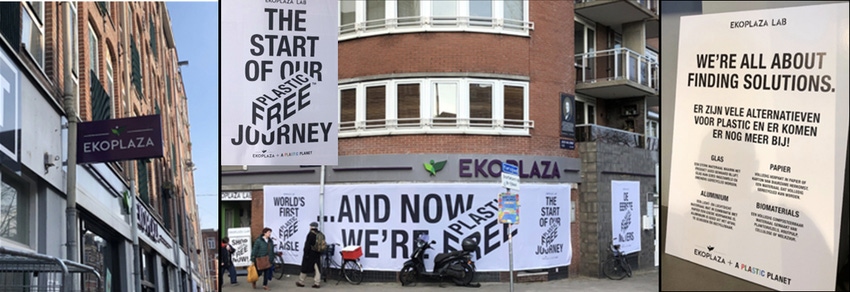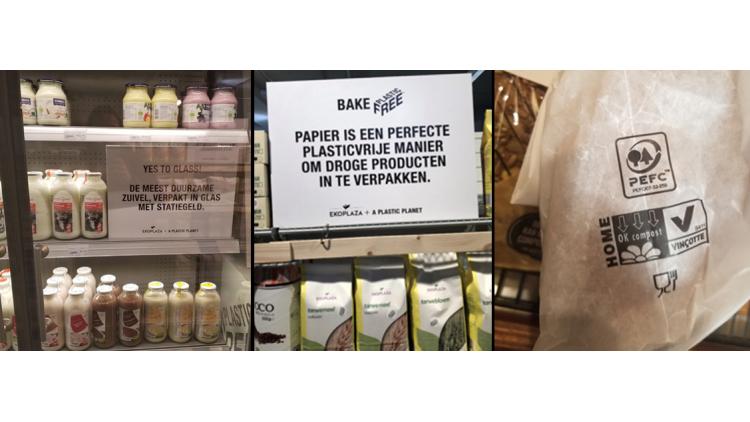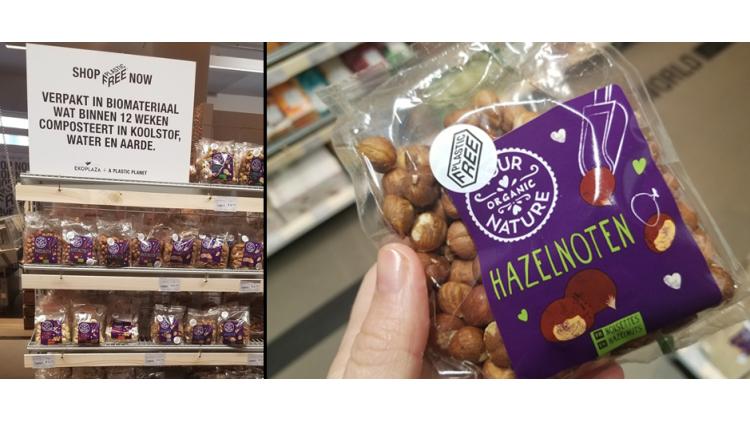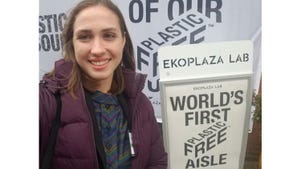The emergence of the ‘plastics-free’ grocery aisle
April 30, 2018

I recently had the opportunity to visit Ekoplaza Lab, which claims to be the world’s first grocery store with a “plastics-free” aisle, and which has generated a lot of buzz in the packaging and environmentalist community. The store is located in Amsterdam, next to a conventional Ekoplaza store, an organic supermarket chain in the Netherlands. As suggested by the use of the word “lab,” Ekoplaza Lab is an experiment—it is a pop-up store marking the beginning of Ekoplaza’s movement towards having a plastic-free aisle in every Ekoplaza store nationwide.
The activist messaging is closely tied to concerns over plastic ocean debris. The experiment was started through a collaboration with the British environmental action group, A Plastic Planet and the Dutch Plastic Soup Foundation. The conventional Ekoplaza store even contains a vending machine with commonly found beach and marine debris items, like plastic utensils, juice boxes and multilayer snack bags.
The Lab itself has significant messaging around “plastic free,” placed at the store entrance as well as on top of shelves explaining the alternatives available and a “plastic free” sticker on every individual package. The main alternatives that the store identifies are glass, paper, aluminum and what they refer to as “bio-materials,” or bioplastics. As shown by these photos, each of these fossil-fuel based-plastic alternatives receives special messaging explaining their environmental benefits.
Glass was advertised as a strong material that is good at preserving product quality and is infinitely recyclable. Aluminum was advertised as a lightweight material that is also infinitely recyclable. Paper was advertised as a plastic-free way to package dry products, and was featured in the baking aisle.
A water-dispensing machine was also on display to promote reusablepackaging.
Finally, “biomaterials” were widely displayed across the store, described as a material made from plant fibers, wood pulp, cellulose or lactic acid, that compost completely within 12 weeks.
Overall the store’s messaging was well thought-out through informative signage and labeling. But is it really plastic free?
The messaging around biomaterials noted “It looks like plastics, but it isn’t.”
It isn’t?
Certainly these materials look and feel much like the plastics we see in other grocery stores all over the world. I must admit I was expecting bulk food bins and more paper and glass alternatives rather than a deluge of compostable films. Other store visitors I spoke with also seemed skeptical. Just because it is made with “biomaterials,” does this mean it isn’t plastic? It leaves the consumer wondering—well, what is plastic anyway?

Biomaterials, biopolymers/bioplastics
Plastics are polymers—complex organic compounds capable of being molded, extruded and cast into various shapes and films. Polymers are most commonly fossil-fuel based, and non-biodegradable. They are derived from crude oil or natural gas and turned into monomers through a “cracking process,” and are then chemically bonded into chains called polymers.
While most of the plastics we interact with daily are derived from petrochemicals, variants are also made from renewable materials, such as polylactic acid (PLA) from corn or cellulose. These renewable material-derived polymers are known as biopolymers or bioplastics.
Biopolymers are polymers too
Needless to say, there is much confusion around the claims “biomaterial” versus “biopolymer” and “bioplastic.” The point, however, is that biopolymers are also plastics, regardless of what material they are derived from. The correct claim then would be bioplastics, not plastics-free.

Some plastics are compostable, but they must be collected
Downstream, bioplastics can be biodegradable or non-biodegradable. Bioplastics that are not biodegradable typically means that they can be recycled along with common plastics, like bio-polyethylene terephthalate (PET) or bio-polyethylene (PE). This is positive, since they look just like fossil-fuel-based plastics and many consumers’ instinct is to recycle them.
Ekoplaza was full of bio-based plastics that are also biodegradable and meet European Union standards for being turned into compost. These bioplastics include PLA, polyhydroxy alkanoates (PHA) and various starch and other blends. They can be composted, but they cannot be recycled by consumers today because of separation issues—they disrupt the normal recycling stream—and volume issues—not enough is collected to merit investing in the needed sorting technology. Rather, consumers should put these items in a compost bin where they will be collected and sent to an industrial composting facility.
Industrial composting infrastructure is much less developed than recycling infrastructure worldwide, and many of these items end up going to landfill or waste recovery, and are not turned into compost. According to European Bioplastics, approximately 35% of the estimated total of recoverable potential organic waste is separately collected at present in Europe, with significant differences between countries. Claims and sales of compostable bioplastics must therefore go hand-in-hand with the development of collection systems and composting infrastructure, or they are meaningless.
In some cases, bioplastics or plastic-coated paper can be home composted, as seen with the OkCompostHOME label on a few of the items at Ekoplaza. But the likelihood of these items turning into usable compost in someone’s home are subject to individual behavior and efficient home composting systems—which means these claims must also go hand-in-hand with composting education.
There is also therefore much confusion around the claims “biodegradable” versus material that actually in the end becomes usable compost. Compostable plastics are a plausible solution for many hard-to-recycle, especially food-contact plastics, but they need to actually end up in the compost. If we are not responsible in our messaging, then they may also become litter in the wrong place.
Role of retailers
Retailers are the critical connector between the product and end consumer. They create choice for consumers in the types of products and packaging they buy. Consumers should have options and be able to make their own choices. Retailers are certainly in a position to nudge consumers to make more sustainable purchasing decisions, and we are we are seeing more of this trend. Ekoplaza Lab is playing an important role in informing consumers and giving them this choice.
In their role as educators, retailers must take care to give the correct information to consumers. In the case of Ekoplaza Lab, the claim of “plastic free” was not correct as there were bioplastics present. While the messaging was effective, the facts were inaccurate.
If Ekoplaza Lab chooses to continue to offer compostable bioplastics in its stores, it might also consider offering messaging and information around composting and perhaps offering compost collection in its stores.
The momentum around marine debris is positive and we should celebrate the experiment to solve it, but recognize the importance of providing full information to consumers and to be factual.

Tristanne Davis joined GreenBlue in November 2017 as a project manager with the Sustainable Packaging Coalition (SPC). Her primary work involves helping to shape and deliver on its Industry Leadership Committee initiatives, ASTRX project and Forest Products work. Davis graduated from the Yale School of Forestry and Environmental Studies in 2016 where she studied Industrial Ecology, Forest and Environmental Sciences. She received a Fulbright Grant in 2016 to get her MBA at IE Business School in Madrid, Spain, where she further developed her interest in environmental entrepreneurship, completing her MBA in July 2017.
************************************************************************************
Production efficiencies, ecommerce challenges, sustainability trends, new bioplastic technologies and more are among the topics on the agenda at the new Packaging Education Hub at EastPack 2018 (June 12-14; NYC). This free educational program will have more than 15 hours of can’t-miss presentations, demonstrations and hands-on activities. Register to attend for free today!
About the Author(s)
You May Also Like


